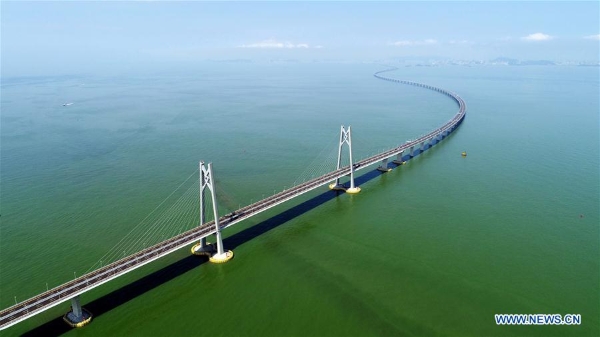World's longest cross-sea bridge opens, integrating Greater Bay Area
 0 Comment(s)
0 Comment(s) Print
Print E-mail Xinhua, October 24, 2018
E-mail Xinhua, October 24, 2018

President Xi Jinping on Tuesday announced the opening of the world's longest cross-sea bridge, which connects the mainland province of Guangdong with the country's two special administrative regions, Hong Kong and Macao.
Praising builders of the bridge for breaking a number of world records, Xi said they demonstrate the nation's spirit of striving to overcome any difficulties, the national strength, the innovative ability, and the aspiration to be the world's best.
The bridge should not only be structurally sound but also well managed, in a bid to contribute to the development of the Guangdong-Hong Kong-Macao Greater Bay Area, he said.
The Y-shaped construction spans over the Lingding Channel in south China meandering for 55 km. Built with an investment of 126.9 billion yuan (about US$18.3 billion), the gigantic project consisting of a series of bridges, artificial islands and a tunnel facilitates travel that used to be separated by channels.
Integration
The mega-bridge has a 6.7-km underwater tunnel. It links the three economic heavy-weights that each have different social systems, economic structures and even languages.
With the swift journeys, the economic belt of the Guangdong-Hong Kong-Macao Greater Bay Area has taken shape and become an economic circle that can be completed in an hour, uniting Hong Kong's financial services, Guangdong's industrial manufacturing and Macao's entertainment industry.
"A bridge spanning over the bay used to be my wild fancy, to make Hong Kong fully exert its commercial radiating potential," said Gordon Ying Sheung Wu, a Hong Kong businessman.
Thirty-five years ago, Wu created a sketch of the bridge over the channel and made it a proposal to the then Hong Kong British authorities, but was ignored.
After Hong Kong returned to the motherland in 1997, entrepreneurs in Hong Kong brought up the proposal again, hoping to integrate development with the mainland.
"Without the bridge, people from Hong Kong facing Zhuhai across the Lingding Channel had to detour via several cities including Shenzhen and Dongguan in the bay area to reach Zhuhai and other cities in the western part of Guangdong," Wu said.
"The bridge construction is a practice of the Chinese policy of 'One Country, Two Systems,' as a great deal of coordinations were carried out under the three different legal and management systems," said Ge Changwei, head of the Guangdong Provincial Commission of Development and Reform.
Under coordination led by the National Development and Reform Commission, the three parties conquered difficulties ranging from financing, construction, and the bridge's ship passage designs to ecological protection, such as schemes for minimizing the impact of the bridge on the Chinese white dolphin, which is under first class state protection.
"With the bridge's opening, the Greater Bay Area with a population of 66 million people, 56,000 square km of coverage and a total GDP equivalent of 1.3 trillion U.S. dollars would spring to a new vitality," said Fang Zhou, director of the Hong Kong-based One-Country-Two-Systems Research Institute.
When delivering her policy address earlier this month, Chief Executive of the Hong Kong Special Administrative Region (HKSAR) Carrie Lam said that the commissioning of the Hong Kong-Zhuhai-Macao Bridge would improve Lantau, HK's largest outlying island, to a "Double Gateway" to the world and other cities in the Guangdong-Hong Kong-Macao Greater Bay Area, as it was the landing point of both the bridge and HK's International Airport.
She said the HKSAR would seize the opportunities brought by the Belt and Road Initiative and the Guangdong-Hong Kong-Macao Greater Bay Area development, with a view to generate new impetus for the HKSAR economy.






Go to Forum >>0 Comment(s)